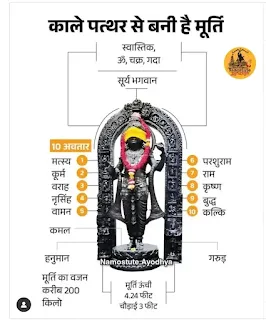The Ram Mandir in Ayodhya, the birthplace of Lord Ram was all decked up for the inauguration and Pran Pratishtha (consecration) ceremony on 22 January 2024. The devotees were waiting for the divine and historic moment with a baited breath. Being a place of cultural and religious significance, Ayodhya, a pilgrim town located in Uttar Pradesh, India is now taking a prominent place on the map of spiritual tourism.
All Facts and Details About Ram Mandir in Ayodhya
Let's unveil some of the most interesting facts and details related to Ayodhya Ram Mandir that you must know:
Ram Lalla's Surya Tilak On Every Ram Navami
A team of scientists designed an innovative system of lenses and mirrors to direct sunlight into the Ayodhya Ram Mandir's sanctum sanctorum, converging on Ram Lalla's forehead on every Ram Navami.
To commemorate Lord Ram's birth, this 'Surya Tilak' will take place every year on the ninth day of the Chaitra month.
The sunlight will fall on the forehead of Lord Ram Lalla from noon for about six minutes on every Ram Navami.
The intricate mechanism of 'Surya Tilak' is designed by a team of scientists at the CSIR – Central Building Research Institute (CBRI), including S K Panigrahi.
An optical lens will be placed on the third floor of the Ram temple, which will direct the ray to the ground floor using a series of reflectors in pipes as explained by R Dharamraju, Chief Scientist at CBRI.
The Indian Institute of Astrophysics contributed to astronomical observations and helped in the creation of mechanical and structural design as told by senior scientist Debdutta Ghosh.
Click Here To Read Mahakumbh Travel Guide
Details About Ram Lalla's Idol
pic credit: namostuteayodhya
The five-year-old Ram Lalla's idol crafted from black stone has been installed in the sanctum sanctorum.
The 51-inch tall and 200-kg in weight, the idol has been carved by the renowned sculptor Arun Yogiraj from Mysuru, Karnataka.
The divine idol features 10 avatars of Lord Vishnu on both sides, five carved on the left side and five on the right side. They include- Matsya, Kurma (tortoise), Varaha (wild boar), Narasimha (half man half lion), Vamana (dwarf), Parashurama, Rama, Krishna, Buddha and Kalki (this incarnation/avatar is yet to appear).
Apart from 10 incarnations of Lord Vishnu, Suryadev, Lord Hanuman and Garun are also carved. Swastika, Om, Chakra, Gada and Lotus are also carved on the idol.
Copper Time Capsule
A time capsule in the form of a copper plate was buried 2000 ft below the Ayodhya Ram temple. The plate is inscribed with relevant information about the temple, Lord Ram and Ayodhya. The aim is to preserve the temple's identity for future generations.
Ram Lalla's Surya Tilak On Every Ram Navami
A team of scientists designed an innovative system of lenses and mirrors to direct sunlight into the Ayodhya Ram Mandir's sanctum sanctorum, converging on Ram Lalla's forehead on every Ram Navami.
To commemorate Lord Ram's birth, this 'Surya Tilak' will take place every year on the ninth day of the Chaitra month.
The sunlight will fall on the forehead of Lord Ram Lalla from noon for about six minutes on every Ram Navami.
The intricate mechanism of 'Surya Tilak' is designed by a team of scientists at the CSIR – Central Building Research Institute (CBRI), including S K Panigrahi.
An optical lens will be placed on the third floor of the Ram temple, which will direct the ray to the ground floor using a series of reflectors in pipes as explained by R Dharamraju, Chief Scientist at CBRI.
The Indian Institute of Astrophysics contributed to astronomical observations and helped in the creation of mechanical and structural design as told by senior scientist Debdutta Ghosh.
Click Here To Read Mahakumbh Travel Guide
Details About Ram Lalla's Idol
pic credit: namostuteayodhya
The five-year-old Ram Lalla's idol crafted from black stone has been installed in the sanctum sanctorum.
The 51-inch tall and 200-kg in weight, the idol has been carved by the renowned sculptor Arun Yogiraj from Mysuru, Karnataka.
The divine idol features 10 avatars of Lord Vishnu on both sides, five carved on the left side and five on the right side. They include- Matsya, Kurma (tortoise), Varaha (wild boar), Narasimha (half man half lion), Vamana (dwarf), Parashurama, Rama, Krishna, Buddha and Kalki (this incarnation/avatar is yet to appear).
Apart from 10 incarnations of Lord Vishnu, Suryadev, Lord Hanuman and Garun are also carved. Swastika, Om, Chakra, Gada and Lotus are also carved on the idol.
Copper Time Capsule
A time capsule in the form of a copper plate was buried 2000 ft below the Ayodhya Ram temple. The plate is inscribed with relevant information about the temple, Lord Ram and Ayodhya. The aim is to preserve the temple's identity for future generations.Ayodhya Ram Mandir's Pran Pratishtha & Inauguration ceremony
Ayodhya Ram Mandir's Pran Pratishtha or consecration ceremony was held on 22 January 2024. Pran Pratishtha is a sacred Hindu ritual that brings the deity to life.
The auspicious occasion witnessed Prime Minister Narendra Modi inaugurating the Ram Temple in Ayodhya. The grand inauguration ceremony was attended by numerous celebrities and VVIPs.
Area & Architectural Details of Shri Ram Mandir
Ayodhya Ram Mandir premises spreads across 70 acres, the temple and the complex is constructed on 5.5 acres. It has become the largest temple in India, based on the design structure.
Around two lakh bricks, collected over 30 years, are used in the construction of the temple. They are all inscribed with Lord Ram's name in numerous languages.
Shri Ram Mandir in Ayodhya has been constructed in the traditional Nagara style architecture.
Chandrakant B Sompura, 81, is the chief architect of the Ayodhya Ram Mandir. Sompura was assisted by his sons Ashish and Nikhil in designing the temple complex. Renowned Sompura family has crafted over 100 temples worldwide, including the revered Somnath Temple.
The Ram Temple stands at 380 ft. length, 250 ft. width and 161 ft. height.
The Ram temple features a three-storied shrine with five Mandaps, 392 pillars and 44 teak doors.
The temple is constructed by Larsen and Turbo and managed by Tata Consulting Engineers Limited (TCEL).
Design Advisors are IIT Bombay, IIT Chennai, IIT Guwahati, NGRI Hyderabad, CBRI Roorkee and SVNIT Surat.
Pink sandstone, teakwood and premium quality materials such as rolled compacted concrete have been used for the construction.
The three-storied temple structure is earthquake-resistant.
Foundation materials used are Granite stone sourced from Telangana and Karnataka along with Pink Sandstone from Bans Paharpur in Bharatpur, Rajasthan.
Pink sandstone, teakwood and premium quality materials such as rolled compacted concrete have been used for the construction.
The three-storied temple structure is earthquake-resistant.
The doors of the temple are made from teakwood, of which the ground floor ones are gold-plated.
A 732 metre boundary wall has been built around the Ram temple complex, though it is not a feature of traditional Nagara style.
A 732 metre boundary wall has been built around the Ram temple complex, though it is not a feature of traditional Nagara style.
No iron or steel has been used in the construction of the temple.
Facts About The Foundation Of Ram Mandir
Foundation materials used are Granite stone sourced from Telangana and Karnataka along with Pink Sandstone from Bans Paharpur in Bharatpur, Rajasthan.
Soil from 2587 holy regions, including Yamunotri, Jhansi, Haldighati, Chittorgarh, Golden Temple, Bithoori and others has been used.
Interesting Facts About Ram Mandir in Ayodhya
The temple idols are crafted from 60 million-year-old Shaligram rocks from the Gandaki River in Nepal.
On the first floor, devotees will find the Ram Darbar.
The temple will have five Mandapas- Nritya Mandapa, Rang Mandapa, Sabha Mandapa, Prarthana Mandapa and Kirtan Mandapa.
The temple bell is crafted from Astadhatu weighing 2100 kg and is audible up to 15 km.
The temple of Lord Hanuman will be in the south of the Ram temple. And Goddess Annapurneshwari temple, along with a kitchen to prepare Lord Ram's bhog will be in the north.
The four temples of Suryadev, Lord Shiva, Lord Ganesha and Godess Durga will be at the periphery.
Sita Kup will be constructed within the premises.
Temples dedicated to Devi Ahilya, Mata Shabri and King Nishad too will also be constructed.
The ancient temple of Lord Shiva on Navratna Kubera Hill will be renovated and a statue of Jatayu will be installed.
At the site of Ram Janmbhoomi, the foundation stone was laid for the construction of the Ram Temple by Prime Minister Narendra Modi on 5 August 2020.
After the event of Bhoomi Pujan, the construction went on in full swing under the supervision of 'Shri Ram Janmabhoomi Teerth Kshetra Trust'.
Sita Kup will be constructed within the premises.
Temples dedicated to Devi Ahilya, Mata Shabri and King Nishad too will also be constructed.
The ancient temple of Lord Shiva on Navratna Kubera Hill will be renovated and a statue of Jatayu will be installed.
FAQs About Ram Mandir, Ayodhya (UP)
When was the foundation of the Ram Temple laid?
At the site of Ram Janmbhoomi, the foundation stone was laid for the construction of the Ram Temple by Prime Minister Narendra Modi on 5 August 2020.
Under whose supervision Ram Mandir was constructed?
After the event of Bhoomi Pujan, the construction went on in full swing under the supervision of 'Shri Ram Janmabhoomi Teerth Kshetra Trust'.











